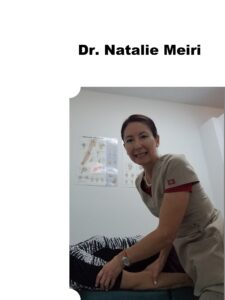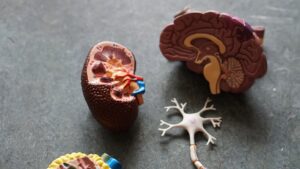
Why do we feel pain and how can chiropractic help?
Your sensory nervous system is what lets you feel pain. Simply put, Chiropractic helps by normalizing function and changing the way your brain processes the pain message.
Your Sensory Nervous System
Your sensory nervous system includes your neurons or nerve cells. Neurons are specialized cells that conduct electrical impulses. Neurons have a cell body, axons and dendrites. Axons are nerve fibers which are message sending projections. Dendrites (free nerve endings) are sensory receptors or message receiving projections. For example, sensory receptors occur in specialized organs such as the eyes, ears, nose, and mouth, back as well as internal organs.
The Message of Pain
The types of sensations that are generally relayed are: 1) pain and temperature 2) touch 3) proprioception (your sense of self movement and position) and vibration.
First, dendrites or free nerve endings are the primary receptors for pain and temperature. The signal is then carried to the nerve cell body in the dorsal root ganglion (sensory cell bodies ) of the spinal nerve.
Second, fibers leaving the dorsal root ganglion enter the spinal cord by accessing Lissauer’s tract. Tracts are neural pathways that are located in the brain and spinal cord. Lissauer’s tract is in the white matter tract in the spinal cord. Axons in Lissauer’s tract run up and down for one or two spinal cord segments before they penetrate the gray matter of the spinal cord. So Gray matter largely functions to receive information and regulate outgoing information, as it contains the cell bodies of neurons. White matter, which is largely composed of axons, serves to transmit signals to other regions of the brain, spinal cord, and body.
Third, the pain message synapses (connects) in the substantia gelatinosa /ventral white commissure which is in the center of the spinal cord. Subsequently, the message ascends (goes up) on the contralateral (opposite) side of the spinothalamic tract in the spinal cord.
Fourth, it ascends to your thalamus in the brain. Finally, it continues to the somatic sensory area of your cortex (brain).

The Somatic Sensory Area of the Brain
The somatic sensory region of the brain is responsible for receiving and processing sensory information from across the body, such as touch, temperature, and pain. Once it has reached this part of your brain you are aware of neck, back or limb pain.
In summary, the brain and spinal cord receive messages/impulses from your sensory nerves. Then the brain sends out patterns of signals to the muscles controlling your arms, legs, and spinal movements in response. For example, if you touch a hot stove, the nerves in your skin shoot a message of pain to your brain. The brain then sends a message back telling the muscles in your hand to pull away. This all happens in an instant.
Chronic Pain
Pain that goes away once the injury has healed and is short-term is acute pain. However, sometimes, those nociceptors (pain receptors) continue to fire. Usually this is due to either a condition that’s causing damage to your tissues or other conditions like arthritis, neuropathy or fibromyalgia. Long-term pain is chronic pain.
For example, if your joint is injured or diseased it causes signals of pain to go back and forth to the brain with little pause. Furthermore, chronic pain can change the way your brain processes pain, laying down different pain pathways. In other words, patients who suffer from chronic pain may actually have their brains altered by the constant pain to be more sensitive to pain and feel it much more intensely than most. Chronic pain usually requires a long-term treatment plan. The regulation of the pain experience has to be changed and new pathways need to be laid down. Chiropractic adjustments to the spine and extremities help in opening up and normalizing the neural pathways.

Theories about Chiropractic Care for Pain Relief
Firstly, of course chiropractic care influences the biomechanical movement patterns of the spine and extremities (limbs) and improves proprioception. It is also becoming clear that chiropractors impact brain function consistently. Additionally, studies are showing chiropractic directly impacts the so called abnormal ‘pain pathways’ in the brain and thus has an effect on a person’s perception of pain.
Secondly, chiropractic adjustments stimulate the dysfunctional tissues around your joints. This stimulation regulates central processing and alters the perception of pain cortically (at the brain) in a ‘top-down’ manner or both..
Thirdly, a majority of the studies have shown neuroplastic effects following a chiropractic treatment. Neural plasticity or brain plasticity, is a process that involves adaptive structural and functional changes to the brain. Moreover, the changes seen in the studies were in somatosensory (sensory system concerned with perception of touch, pressure, pain, temperature) processing, motor control and functional performance.
Fourthly, alternatively, chiropractic spinal adjustments may also alter pain perception via the neuroendocrine (nerve and hormonal) system.
Why Do We Feel Pain and How Can Chiropractic Help?
Pain is not always bad. Pain alerts you to move your hand off the hot stove. However, chronic pain can be debilitating which is why so many people turn to pain killers to manage the pain. But it doesn’t have to be that way.
Chiropractic is for people who want to move, perform better in life and be pain free. Chiropractic is an all-natural, drug free, nonsurgical option to help people who suffer with musculoskeletal pain, both acute and chronic.
Meiri Chiropractic serving West Palm Beach, Jupiter, North Palm Beach, and Palm Beach Gardens offers chiropractic treatment for acute and chronic pain. Do you want to be pain free? Call 561-253-8984 today to schedule an appointment.




